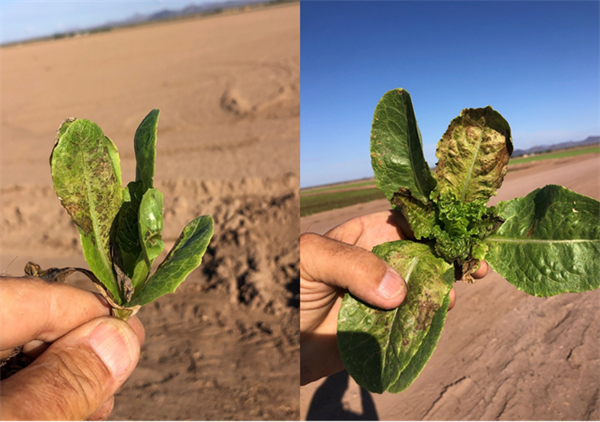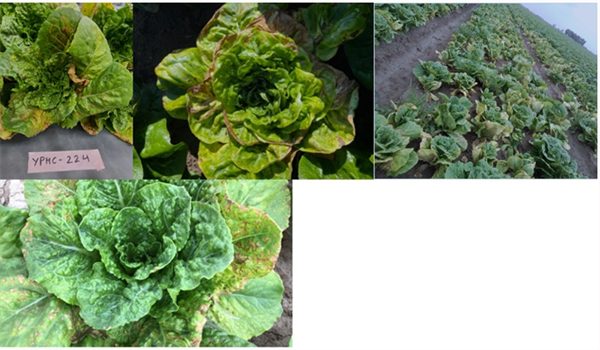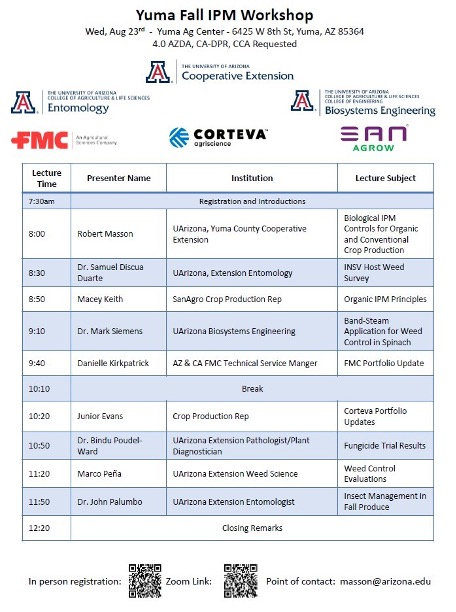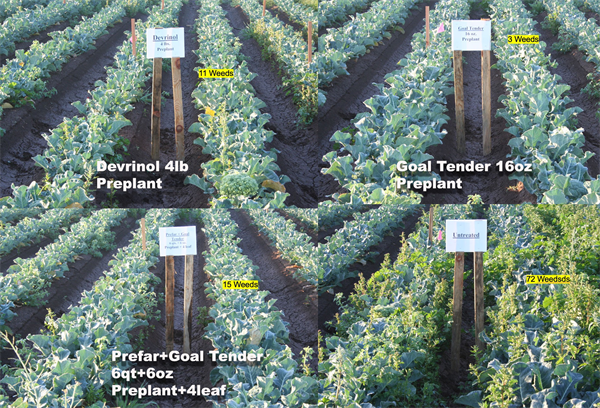-
Nov 2, 2022Thrips Management in Fall Lettuce Important as Ever
As expected, INSV infected plants have been found again in desert lettuce. We confirmed out first case for the 2022 Fall season on Oct 14th in organic romaine transplants in Tacna. This is almost the same time as last fall (INSV was confirmed in Fall 2021 on Oct 9th). Additionally, this week we confirmed the presence of INSV in another organic romaine field located several miles away. Not surprising since the plants originated from Salinas where INSV outbreaks have been widespread. What’s most concerning is that the virus is now beginning to spread to adjacent lettuce. We found INSV infected plants in 3 direct-seeded lettuce (romaine and iceberg) fields growing downwind of one of the infected organic romaine fields. Fortunately, the incidence of INSV is less than 0.5% in these blocks. However, to prevent further spread to adjacent fields, management of thrips in infected lettuce is advised.
Historically, management of thrips was targeted at preventing damage caused by thrips feeding to marketable lettuce leaves. Typically, PCAs could allow for thrips to build up during early part of plant growth, and then eventually prevent feeding damage on marketable leaves with 2-3 well timed foliar insecticide applications. However, that all changed with the discovery of INSV in desert lettuce. It’s important to understand how thrips infect lettuce plants with INSV. INSV infects lettuce two ways. The first is Primary infection where INSV infected adults move into a lettuce field and begin feeding, simultaneously transmitting INSV to otherwise healthy plants. In theory, the greater the number of infected thrips moving into the field, the higher the incidence of primary infection. Secondary infection or spread occurs when poplations colonize and thrips larvae acquire INSV by feeding on an infected plant (either lettuce or nearby weeds), complete development and emerge as infected adults, capable of transmitting INSV throughout the field or nearby lettuce fields/weeds. Keep in mind, adults only transmit INSV, whereas only larvae acquire the virus from an infected plant. To minimize the areawide spread of INSV this fall and into next spring, PCAs should consider the following recommendations:
Early and aggressive spray timing in High-risk areas. It is advisable that PCAs preventatively treat lettuce fields early and aggressively in the following high-risk scenarios:- Lettuce originating from Salinas should be treated before or shortly after transplanting.
- Direct-seeded lettuce fields grown next to, or near, lettuce and brassica fields where transplants originated from Salinas should be treated early and aggressively.
Focus on minimizing Secondary spread. Because adults can be difficult to control, prevent larvae from completing development to the adult stage and moving throughout the field. It’s hard to prevent primary infection from the outside but minimizing larvae populations should help suppress the secondary spread of INSV if it is present in the field. In other words, “Nip the thrips” populations in the bud.
Using Insecticides Differently. Consider incorporating the following approaches in your IPM programs:- Adding Lannate or Torac with chemical thinners/smart sprays.
- Rotating Minecto Pro or Exirel with Radiant for Lep and/or whitefly control in fall lettuce
- Rotating Beleaf or Acephate with Movento when aphid control is needed.
- All these products have shown to provide control or suppression of western flower thrips larvae.
Test symptomatic plants immediately. The earlier you confirm INSV in a field the better chance you have of reducing secondary spread within the field and, perhaps as important, to surrounding lettuce in the area. Immunostrip test kits are available, and the UA Diagnostic Plant Pathology Diagnostic Lab can confidentially confirm the presence of INSV on symptomatic plants.
Season-long sanitation. Research over the past year has shown that several deserts weed species are reservoirs for both thrips and INSV. Reduction of thrips/INSV can be achieved with thorough weed control, both in and around produce fields. Additionally, once lettuce harvest is complete, growers should disk crop residue as quickly as possible to reduce prolonged thrips reproduction and spread. For more information, please go to this link: Thrips and INSV Management in Desert Lettuce
INSV infected romaine plants – Yuma, AZ October 2022To contact John Palumbo go to: jpalumbo@ag.Arizona.edu











